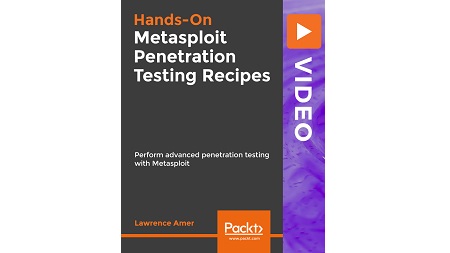
English | MP4 | AVC 1920×1080 | AAC 48KHz 2ch | 2h 05m | 460 MB
Evade antiviruses, bypass firewalls, and exploit complex environments with the most widely used penetration testing framework
Metasploit is a Ruby-based platform for performing advanced penetration testing. It enables you to write, test, and execute exploit code. The Metasploit framework contains a suite of tools that you can use to test security vulnerabilities, enumerate networks, execute attacks, and evade detection.
In this course, you’ll go through some great recipes that will allow you to build on your existing Metasploit knowledge and start using it effectively. You’ll improve your skills with some best practices and techniques and implement some troubleshooting issues you’ll encounter using Metasploit. You’ll learn to perform intelligence gathering, threat modeling, vulnerability analysis, exploitation, and post-exploitation―all inside Metasploit.
You’ll learn to create and customize payloads to evade antivirus software, bypass an organization’s defenses, exploit server vulnerabilities, attack client systems, compromise mobile phones, automate post exploitation, install backdoors, run keyloggers, highjack webcams, port public exploits to the Metasploit framework, create your own modules, and much more.
By the end of this course, you’ll be proficient with many tools and techniques and will have mastered everything you need to perform penetration testing using Metasploit and virtual machines.
Learn
- Prepare the Metasploit framework and set up labs locally and remotely
- Understand Metasploit fundamentals
- Conduct penetration testing on different target scopes
- Perform client-side attacks on browsers and devices (bypassing AV detection)
- White- and black-box penetration testing steps
- Post exploitation on Windows and OS X
- Construct custom modules from scratch
Table of Contents
Preparing the Environment
1 The Course Overview
2 Setting Up Local Penetration Testing Lab
3 Launching Your Remote Penetration Testing Lab with Cloud Engine
4 Easy Guide for Installation of Metasploit Framework
Conducting Metasploit Penetration Testing
5 Get Scanning Techniques by Nmap and Zenmap
6 Pentesting Windows XP for Known Attacks
7 Pentesting Windows 7 for Known Attacks
8 Pentesting Linux for Known Attacks
9 Pentesting Windows Servers for Known Attacks
10 Pentesting Databases for Known Attacks
11 Art of Metasploit on a Real Hacking Scenario
White Box Metasploit Penetration Testing
12 Setting Up Configuring OpenVAS
13 Porting Results of OpenVAS into Metasploit
14 Verifying Results and Covering Logs
15 Generating Detailed Reports
Black Box Metasploit Penetration Testing
16 Footprinting and Enumeration
17 Exploitation of Vulnerable Software Found
18 Elevating Your Specific Low Privileges
19 Moving Inside the Network with Pivoting
20 Mastering Nessus Integration
Client-Side Attacks
21 Client-Side Exploitation with Browser Vulnerabilities
22 Understanding Metasploit Payloads
23 Bypass the Detection of AV
24 Attacking Web Visitors with Malicious Injection
25 Injecting Your Metasploit Payload into Safe Package
26 Exploiting Mobile Devices
27 Getting Started with Social Engineering Toolkit (SET)
Post Exploitation
28 Usage of Windows- CaptureGatherManage Modules
29 Usage of Linux Post Exploitation Modules
30 Usage of OS X Post Exploitation Modules
Building Custom Exploits
31 Fuzzing and EIP Control
32 Finalizing Exploit Development
33 Porting Exploit into Metasploit
Resolve the captcha to access the links!